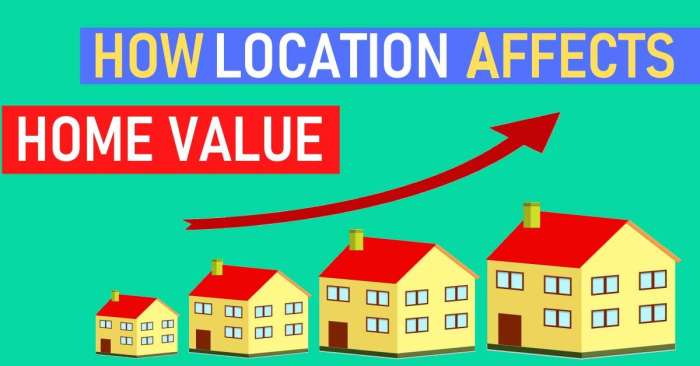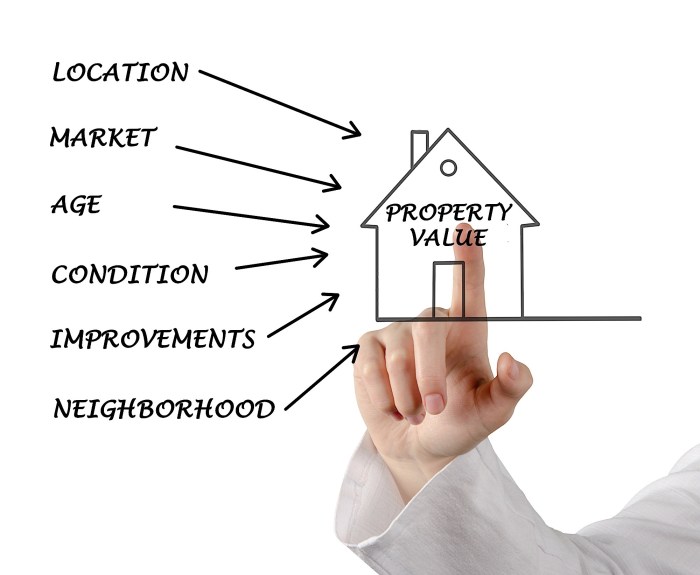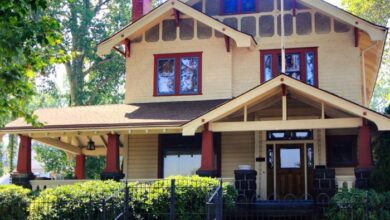How Location Affects Property Value What You Need To Know
Understanding how location affects property value is crucial for both buyers and sellers in the real estate market. The interplay between geography and property desirability can often mean the difference between a thriving investment and a less favorable one.
From the bustling streets of urban centers to the serene landscapes of rural areas, various factors like amenities, school quality, and crime rates shape property values. Recognizing these elements can provide valuable insights for making informed decisions in real estate.
Understanding Property Value
Property value is a critical aspect of real estate that reflects the worth of a property in the marketplace. It is influenced by a variety of components including location, property condition, and market demand. Understanding these elements is essential for buyers, sellers, and investors alike as they navigate the complex real estate landscape.The determination of property value in the real estate market hinges on several key factors.
Primarily, it is assessed through a comparative market analysis (CMA), which evaluates similar properties that have recently sold in the same area. Appraisers and real estate professionals consider various elements such as size, age, style, and condition of the property, along with the features and amenities it offers. Furthermore, external factors like neighborhood characteristics, school district ratings, and proximity to essential services also play significant roles in shaping property values.
Components Influencing Property Value
Understanding the various components that influence property value can provide insight into the dynamics of the real estate market. Here are some critical factors:
- Location: The geographical area where a property is situated greatly affects its desirability and value. Properties in prime locations, such as urban centers or affluent neighborhoods, typically command higher prices due to demand.
- Market Conditions: The state of the real estate market—whether it’s a buyer’s or seller’s market—impacts property values. In a seller’s market, where demand exceeds supply, property values tend to rise.
- Property Size and Layout: Larger properties or those with functional layouts often have higher values. The number of bedrooms and bathrooms, as well as usable living space, are significant considerations.
- Condition and Age: Well-maintained properties that are up to date with renovations or have modern features tend to fetch a higher price compared to older properties needing repairs.
- Amenities: Features such as swimming pools, gardens, or energy-efficient systems can add considerable value to a property. These amenities are attractive to potential buyers and can justify higher asking prices.
- External Factors: Elements such as crime rates, noise levels, and the quality of local schools deeply influence a property’s appeal and price point. Properties in safe, quiet areas with good educational facilities are often more valuable.
Property value is not static; it fluctuates based on both macroeconomic and microeconomic factors, making it crucial to stay informed about market trends.
Keeping these factors in mind can assist in making informed decisions whether you are buying, selling, or investing in real estate.
The Influence of Location
The geographical location of a property plays a pivotal role in determining its market value. Various factors contribute to how desirable a location is, influencing both residential and commercial property prices. Understanding these elements can help buyers, sellers, and investors make informed decisions regarding property transactions.One significant aspect of location is how urban and rural settings differ in property value.
Urban areas tend to have higher property values due to denser populations, which create a greater demand for housing and commercial spaces. For instance, a two-bedroom condo in downtown San Francisco can easily command prices over a million dollars, while a similar property in a rural town might sell for a fraction of that. The population density in urban locations leads to increased competition for limited space, driving prices up.
Conversely, rural areas typically offer larger properties for lower prices, but the trade-off often includes fewer job opportunities and amenities.
Proximity to Amenities and Services
The importance of being close to essential services and amenities cannot be overstated when it comes to property values. Buyers often seek out locations that provide easy access to schools, shopping centers, healthcare facilities, and recreational areas. Properties situated near these conveniences tend to hold their value better and appreciate over time.For example, consider a neighborhood within walking distance of a well-regarded school, a grocery store, and parks.
Such a location may see property values rise significantly compared to similar homes situated further away from these amenities. This is due to the desirability these features create, especially for families looking for a convenient lifestyle. Additionally, public transport access can vastly influence property values. Homes located near subway stations or bus stops generally have higher prices, as they provide greater connectivity to the city and surrounding areas.
A property in a transit-friendly area may appreciate more rapidly due to the increased desirability among commuters.In summary, when evaluating property value, the geographical location along with its proximity to essential services plays a crucial role, shaping market trends and investment potential. Understanding these dynamics enables stakeholders to make strategic decisions in the real estate landscape.
Economic Factors
Local economic conditions play a significant role in determining property values within a community. Factors such as employment rates, average income levels, and the presence of local businesses contribute to the overall market landscape. A thriving economy often leads to increased demand for housing, directly impacting property values.In areas where job markets are robust, property values tend to appreciate due to higher disposable incomes and increased consumer confidence.
Local economic growth fosters a competitive real estate market, while regions affected by high unemployment often experience stagnation or decline in property values. This correlation highlights the importance of economic vitality in real estate investment decisions.
Job Market Influence
The relationship between job markets and property values can be illustrated through the following key points:
- Strong Job Markets: Areas with low unemployment rates, such as tech hubs or cities with major corporate headquarters, often see a surge in housing demand. For example, cities like San Francisco or Austin, known for their booming tech industries, have consistently high property values due to an influx of well-paying jobs.
- High Unemployment Areas: Conversely, regions suffering from economic downturns, such as Rust Belt cities like Detroit, have seen property values plummet as residents seek better opportunities elsewhere. High vacancy rates and abandoned properties further depress local markets.
- Consumer Confidence: When the job market is strong, consumer confidence increases, leading to more home purchases and higher property values. Buyers are more willing to invest in real estate when they feel secure in their employment and financial situations.
- Local Business Development: The establishment of new businesses can significantly impact property values. Areas with active business development attract a workforce, which in turn creates demand for housing. For example, the redevelopment projects in downtown areas can lead to a revitalized local economy, boosting property values significantly.
“Local economic conditions are often the backbone of property value fluctuations, strongly dictating the real estate landscape.”
School Districts and Education Quality
The quality of local schools plays a significant role in determining property values in a given neighborhood. Homebuyers often prioritize proximity to high-rated schools, making the educational landscape a pivotal factor in real estate decisions. Areas served by reputable school districts tend to see a steady demand, leading to increased property values over time. One clear indication of how education impacts real estate is the correlation between school performance metrics and home prices.
Families are willing to pay a premium for homes in districts with strong academic records, dedicated teachers, and a variety of extracurricular options. Research has shown that homes located within the boundaries of top-rated school districts can command prices that are significantly higher than those in less favorable areas.
Examples of Neighborhoods with High-Rated Schools
Several neighborhoods across the country exemplify this trend, showcasing the link between quality education and real estate values. Here are a few notable examples:
- Palo Alto, California: Known for its exceptional public schools, Palo Alto’s real estate market is one of the most sought-after in the nation. Properties here often sell for above the median price due to the area’s reputation for educational excellence.
- Lake Forest, Illinois: This suburban Chicago community boasts top-ranking schools, contributing to its high property values. Homes in Lake Forest typically appreciate in value more quickly than those in neighboring districts lacking in school performance.
- Westfield, New Jersey: With its award-winning school district, Westfield draws families looking for a blend of suburban charm and high-quality education. The town’s properties often see robust demand, pushing prices upward.
- Scarsdale, New York: This affluent suburb is renowned for its outstanding school system, which heavily influences the local real estate market. Homes here are consistently priced higher due to the desirability of the education options available.
The influence of outstanding school performance is further supported by various metrics such as standardized test scores, graduation rates, and college acceptance rates. Neighborhoods with schools that consistently achieve high marks in these areas generally command higher real estate prices.
“The value of a home can increase by 15% or more simply by residing in a highly rated school district.”
For instance, a study from the National Bureau of Economic Research highlighted that homes located in school districts with an A rating can sell for approximately $50,000 more than similar homes in B-rated districts. Families often consider the long-term benefits of good education, leading to a stronger demand for homes in these areas. Overall, the link between school districts and property values underscores the importance of education quality in real estate.
Homebuyers are increasingly recognizing that investing in properties near top schools not only benefits their children’s education but also serves as a sound financial decision.
Safety and Crime Rates

Source: robertgilljr.com
The safety of a neighborhood is a key factor that significantly impacts property values. When potential homeowners consider buying a property, they often prioritize their safety and the security of their families. Neighborhoods with higher crime rates generally see a decline in property values, as buyers become wary of the risks associated with living in those areas. Understanding how crime rates influence property values can help prospective buyers and sellers make informed decisions.Crime rates serve as a critical indicator of neighborhood safety and can directly affect property values.
Areas with low crime rates tend to attract families, professionals, and investors, leading to increased demand and higher property values. On the other hand, neighborhoods with high crime rates often experience stagnation in property values or even declines, as potential buyers seek safer environments. Real estate agents frequently use crime statistics as a pivotal selling point, highlighting safer areas to prospective buyers.
Impact of Crime Rates on Property Values
The relationship between crime rates and property values is well documented. Studies have shown that neighborhoods with lower crime rates often enjoy a price premium compared to those with higher crime rates. Here are some important insights into how safety impacts property values:
- Statistics reveal that homes in low-crime areas can command prices that are 20-30% higher than similar homes in high-crime neighborhoods.
- According to the FBI’s Uniform Crime Reporting (UCR) Program, areas with lower violent crime rates see quicker property sales and fewer price reductions during negotiations.
- Neighborhoods that have implemented community safety initiatives, such as neighborhood watch programs, often experience a stabilization or increase in property values as safety improves.
The perception of safety is crucial among potential buyers. Even if crime statistics indicate a decline in criminal activity, lingering perceptions can deter buyers. For instance, if a neighborhood has recently experienced a spike in crime, even if it returns to lower levels, the fear associated with that spike can linger, affecting buyer interest and property prices.
“Safety and security are paramount considerations for homebuyers; neighborhoods perceived as unsafe struggle to attract potential buyers, irrespective of actual crime statistics.”
In summary, the interplay between crime rates and property values is a vital part of the real estate landscape. Safe neighborhoods not only attract buyers but also contribute to a thriving community environment. Understanding this relationship can empower buyers to make informed choices about their investments and help sellers position their properties strategically in the market.
Future Development and Urban Planning
Understanding how planned infrastructure projects and urban planning initiatives impact property values is crucial for both current and prospective property owners. These developments can significantly influence the desirability of a location, affecting everything from accessibility to local amenities.
Planned Infrastructure Projects
Planned infrastructure projects, such as new highways, public transit systems, or community facilities, can lead to increased property values. These improvements often enhance connectivity, making areas more attractive to potential buyers and investors.
“Infrastructure investments are a catalyst for economic growth and property appreciation.”
For instance, the introduction of a new subway line in a metropolitan area can transform previously underdeveloped neighborhoods into hot property markets. As accessibility improves, demand for housing in these areas typically rises, driving up prices. In addition to transportation improvements, new parks and recreational facilities can also boost neighborhood appeal, further increasing property values.
Zoning Laws and Land Use Regulations
Zoning laws and land use regulations play a pivotal role in shaping property markets by determining how land can be used and what types of developments are permissible. Understanding these regulations is essential for anyone considering property investment.
- Residential zoning limits can lead to a scarcity of housing options, which may drive up prices if demand remains high.
- Commercial zoning can influence the types of businesses that operate in an area, impacting foot traffic and, consequently, local property values.
- Changes in zoning laws can also provide opportunities for redevelopment, which can significantly elevate property values in the long term.
For example, a change in zoning that allows for higher-density residential buildings can result in increased property development, attracting new residents and increasing overall property values.
Gentrification Trends
Gentrification is a complex phenomenon that often results from urban revitalization efforts and can have significant impacts on local property markets. As neighborhoods become more desirable, property values can rise sharply, potentially displacing long-term residents.This trend can lead to a range of outcomes for property investors and homeowners.
- Initial property investments may see rapid appreciation as new amenities attract higher-income residents.
- Long-term residents may face increased property taxes and living costs, leading to community displacement.
- Local businesses may thrive initially but could struggle as the demographic shifts change consumer behavior.
Cities like San Francisco and Brooklyn have experienced notable gentrification, where previously overlooked areas have transformed into sought-after neighborhoods, illustrating the impact of urban planning and development on property values. It’s vital for investors to assess these trends carefully, as they can yield both opportunities and challenges in the real estate market.
Environmental Factors
Environmental features play a crucial role in determining property value. Homebuyers are often drawn to properties that offer access to parks, scenic views, and bodies of water. These natural amenities not only enhance the quality of life for residents but also have a direct impact on property prices. The appeal of living close to nature can significantly elevate the desirability and value of a home.Natural disasters and climate change present significant challenges that can adversely affect property prices.
Areas prone to flooding, wildfires, or hurricanes often see reduced demand, which can lower property values. As climate change continues to reshape environmental conditions, properties in high-risk zones may require additional evaluation or even insurance costs, further influencing market trends.
Impact of Natural Amenities on Property Value
Proximity to environmental features can lead to higher property values due to the lifestyle benefits they provide. Here are some key aspects that make natural amenities attractive to buyers:
- Parks and Green Spaces: Nearby parks enhance community living and promote outdoor activities, which many families value. Homes near parks often see a price premium as they provide recreational opportunities.
- Bodies of Water: Properties with lake, river, or ocean views typically command higher prices due to their scenic attractiveness. Waterfront homes are particularly desirable, often leading to a significant increase in market value.
- Scenic Views: A home with picturesque views, whether of mountains, valleys, or urban skylines, can be more appealing. These views contribute to a sense of tranquility and beauty, influencing buyers’ willingness to pay more.
Effects of Natural Disasters and Climate Change
The implications of natural disasters and climate change on real estate are profound. Many buyers are now prioritizing safety and sustainability in their purchasing decisions. The following points illustrate this trend:
- Insurance Costs: Properties in disaster-prone areas often face higher insurance premiums, which can deter potential buyers and lead to lower property values.
- Resilience Measures: Homes that incorporate features designed to withstand natural disasters (e.g., elevated structures in flood zones) are more appealing to cautious buyers, potentially increasing their value.
- Market Trends: Areas identified as at risk due to climate change may see declining property values, while regions perceived as safer or more sustainable can experience growth in demand and pricing.
Eco-Friendly Developments and Market Appeal
Eco-friendly developments are becoming increasingly popular among buyers who prioritize sustainability. These developments typically feature energy-efficient designs, renewable energy sources, and environmentally friendly materials, which can enhance property values. Notable examples include:
- LEED-Certified Buildings: Properties that meet Leadership in Energy and Environmental Design (LEED) standards are often more appealing due to their lower environmental impact, resulting in increased market value.
- Community Gardens and Green Roofs: Developments that incorporate communal green spaces and gardens promote sustainability and community engagement, enhancing their market appeal.
- Smart Home Technology: Homes equipped with energy-efficient appliances and smart technology can attract environmentally conscious buyers, thereby increasing property values.
Cultural and Social Influences

Source: fortunebuilders.com
Local culture and community characteristics play a pivotal role in determining property values. When prospective buyers evaluate a neighborhood, they often consider not just the physical attributes of homes but also the lifestyle and amenities that the area has to offer. The cultural vibe, demographic makeup, and available community resources can significantly sway a buyer’s decision, thereby affecting property values.The demographics of an area greatly influence its desirability.
A neighborhood with a diverse population may attract buyers looking for a rich cultural experience, while areas with a strong sense of community can foster a welcoming environment that appeals to families. Ultimately, these factors contribute to how individuals perceive the value of a property.
Community Amenities and Their Impact
Community amenities like theaters, restaurants, and local festivals add immense value to properties by enhancing the quality of life in a neighborhood. These features can create a vibrant atmosphere that attracts homebuyers.
- The presence of cultural institutions such as museums and art galleries not only enriches the community’s cultural fabric but also makes the area more attractive to potential buyers who value arts and culture.
- An array of dining options, from casual eateries to fine dining establishments, can elevate neighborhood appeal. Areas known for their culinary scene often see a surge in property demand, as food-loving residents seek out vibrant local flavors.
- Community events like street fairs and local festivals foster a sense of belonging and connection among residents. They also serve as a draw for new residents who appreciate an active, engaged community life.
- Parks and recreational facilities enhance property values by providing residents with spaces for leisure activities, contributing to a healthier lifestyle.
“Neighborhoods with rich community amenities often experience higher property appreciation rates, reflecting their desirability among homebuyers.”
As neighborhoods evolve, the cultural and social influences at play continue to shape property values, influencing buyers’ sentiments and decisions significantly. Whether it’s through the vibrancy of community events or the charm of local eateries, these factors are essential to understanding the complete picture of property valuation.
Market Trends and Cycles

Source: cloudfront.net
The real estate market is inherently cyclical, influenced by a variety of factors that can significantly impact property values. Understanding these cycles provides insight into when to buy, sell, or hold property based on prevailing trends. This segment delves into the nature of these cycles, how global economic events can influence local markets, and offers a historical perspective on the fluctuations in property values through various market phases.The cyclical nature of real estate markets showcases distinct phases: expansion, peak, contraction, and trough.
Each phase has distinct characteristics that affect property values. During the expansion phase, demand typically outpaces supply, leading to rising prices and increased construction. Conversely, the contraction phase often sees a surplus of inventory, which can result in price declines as sellers lower asking prices to attract buyers. The impact of these cycles is profound; for instance, properties purchased during a downturn can appreciate significantly as the market recovers.
Cyclical Nature of Real Estate Markets
Market cycles are influenced by several factors, including interest rates, job growth, and consumer confidence. Understanding these elements can help predict shifts in property values. Key components include:
- Interest Rates: Lower interest rates often stimulate buyer demand, leading to increased property values. Conversely, higher rates can dampen demand and suppress prices.
- Employment Rates: A growing job market typically boosts consumer confidence, resulting in higher demand for homes and increased prices.
- Supply and Demand Dynamics: When demand exceeds supply, prices rise. However, if new construction outpaces demand, property values may decline.
Global economic events can substantially affect local real estate markets, demonstrating the interconnectedness of today’s economies. For example, a recession in a major economy can lead to reduced consumer spending worldwide, directly impacting local markets through decreased demand for properties. Events such as the 2008 financial crisis serve as a stark reminder of how quickly market conditions can shift.
Impact of Global Economic Events
Global economic shifts can have immediate repercussions on real estate values. Important considerations include:
- Financial Crises: Global financial downturns can lead to tight credit conditions, making it more challenging for buyers to secure mortgages, which subsequently lowers demand and prices.
- International Trade Policies: Changes in trade policies can affect local economies, especially in areas reliant on specific industries, influencing real estate demand and pricing.
- Foreign Investment: Fluctuations in foreign investment can drastically alter local real estate markets, as increased investment can drive up prices, while decreases can lead to stagnation.
The historical context of property values reveals significant fluctuations through market booms and recessions. From the post-World War II housing boom to the dot-com bubble and the more recent Great Recession, property values have experienced vast changes. Examining these historical trends unravels the relationship between broader economic conditions and real estate performance.
Historical Perspective on Property Values
Analyzing historical property value trends can provide crucial insights into future behaviors. Noteworthy points include:
- The Post-War Boom: Following World War II, the introduction of suburban living and increased consumer spending led to a significant rise in property values.
- The Dot-Com Bubble: The late 1990s saw a surge in tech-driven investments, which subsequently inflated property values in tech-centric areas before a sharp decline in the early 2000s.
- Great Recession: The housing bubble burst in 2008 resulted in a nationwide decrease in property values, which took several years for recovery.
Understanding the cyclical nature of real estate markets and their susceptibility to global events is crucial for making informed property investment decisions. By analyzing historical trends, investors can better anticipate the potential impacts of current market conditions on future property values.
Ending Remarks
In conclusion, the impact of location on property value underscores the importance of thorough research and understanding of local markets. By considering elements like economic conditions, educational facilities, and future development, stakeholders can better navigate the complexities of real estate investments.
Popular Questions
How does location influence resale value?
Location significantly affects resale value, as desirable neighborhoods often attract more buyers, leading to higher property prices.
What role do public transport options play in property value?
Proximity to public transport can enhance property value by making areas more accessible, appealing to commuters and increasing demand.
Can property values increase in low-demand areas?
Yes, property values can rise in low-demand areas due to future developments or improvements in local amenities and infrastructure.
How can local government impact property values?
Local government decisions on zoning, taxes, and infrastructure projects can significantly influence property values by affecting desirability and investment potential.
What is the effect of environmental features on property values?
Environmental features like parks, lakes, and scenic views can enhance property values, attracting buyers looking for a pleasant living environment.









